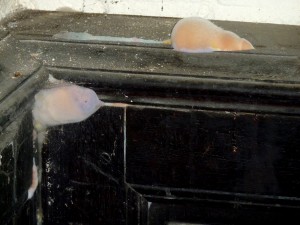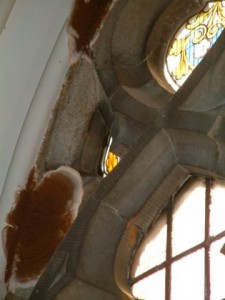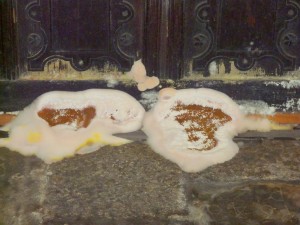In a previous post, we showed pictures of the dramatic effect that wet rot had on the structure of one of the bosses in the former East Kirk. This was caused by water getting in through the leaking roof. We have also had problems with dry rot. The name is slightly misleading since it too has a need for an increased level of moisture, but this is lower than with wet rot. Dry rot normally thrives with 20-40% moisture.
The fungus Serpula lacrymans is the main cause of dry rot. An outbreak starts with a spore germinating when conditions are right (often about 30% moisture). This develops thread-like hyphae which are capable of finding ways through stone and mortar as well as wood. A mass of hyphae forms a mycellium, which can look like grey fur (as shown in the first photograph).  Growth of the fungus in wood rapidly destroys its strength so that it may no longer be capable of load bearing in a building. Eventually the fungus will produce a ‘fruiting body’ to release more spores. The hyphae can travel considerable distance from the original spore. One of the outbreaks we have had started inside the gallery structure and was first seen two storeys lower and about 20 feet away.
Growth of the fungus in wood rapidly destroys its strength so that it may no longer be capable of load bearing in a building. Eventually the fungus will produce a ‘fruiting body’ to release more spores. The hyphae can travel considerable distance from the original spore. One of the outbreaks we have had started inside the gallery structure and was first seen two storeys lower and about 20 feet away.
 Often dry rot will start when a building is starting to dry out. This has been the case with the former East Kirk building, where there have been a number of outbreaks. The fruiting bodies can appear on wood or stone, as shown in the photographs. The first one shows a fruiting body on stone (above a window in the gallery).
Often dry rot will start when a building is starting to dry out. This has been the case with the former East Kirk building, where there have been a number of outbreaks. The fruiting bodies can appear on wood or stone, as shown in the photographs. The first one shows a fruiting body on stone (above a window in the gallery).
 The second shows it on some of the 17th century carved wood in St Mary’s Chapel. The orange colour is caused by the spores ready to be released.
The second shows it on some of the 17th century carved wood in St Mary’s Chapel. The orange colour is caused by the spores ready to be released.
Treatment is possible, but the sooner the better – so constant vigilance is required where there is a known risk.